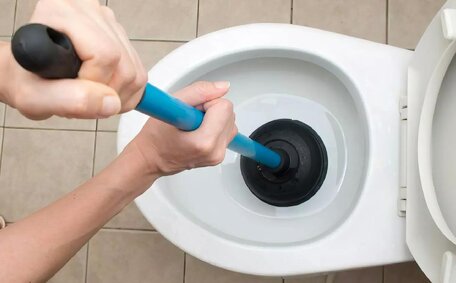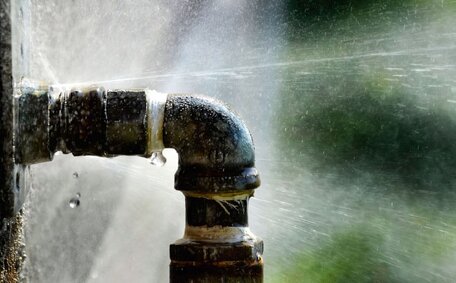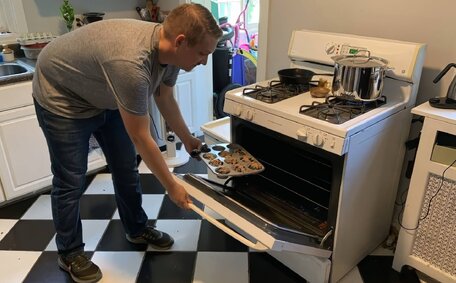A noisy toilet can significantly disrupt a household. If your toilet makes noises such as hissing, gurgling, or banging during flushing, this often indicates problems with components inside the toilet tank. Issues with the inlet valve, flapper, water supply line or float can all contribute usually indicates issues with toilet tank components.
This article offers DIY troubleshooting tips to diagnose and fix common causes of noisy toilets. The article aims to offer practical solutions to quieten your toilet and ensure it functions correctly.
Clear instructions are provided for adjusting or replacing parts like the fill valve, flapper, or float to address post-flush noise issues.
Understanding Common Toilet Noises
Common Noises and Their Causes
Toilets can emit various noises, each suggesting different issues:
- Hissing - Often caused by water flowing into the toilet bowl through a faulty fill valve that doesn’t seal properly.
- Gurgling Bubbling - Indicates air or water bubbles travelling through pipes. Could point to a blocked vent stack or issues with the flush valve.
- Banging/Hammering - Also called 'water hammer’. Loud banging noises likely stem from quick-closing valves and excessive water pressure.
- Phantom Flushing - Strange sounds, akin to running water, with no one actively flushing. Potentially signals problems with the float, flapper or refill tube.
Identifying the Source of Noise
Identifying the source of the noise is crucial for an accurate diagnosis. Noises that mimic a foghorn noise after the toilet is flushed likely point to components inside the toilet tank like the flapper, valves or fill tube. Noises emanating from the pipes typically suggest problems with water flow and pressure.
Impact on Homeowners
While not necessarily signaling major plumbing issues, ongoing toilet noises should be addressed to prevent disruptions and mitigate the risk of leaks or flooding. Persistent banging following flushes can accelerate wear on components such as the water heater, often caused due to abrupt water pressure changes.
Hissing Sounds
Hissing sounds from a fill valve toilet often indicate water flowing improperly into tank due to issues with the fill valve. As water flows into the tank after flushing, a hissing noise can signal that the fill valve seal is faulty or worn out, allowing water to leak out and create that hissing sound.
Improper water flow into the overflow tube, typically caused by a water level set too high, can also result in a hissing noise.
Other potential reasons that affect your toilet water include:
- Sediment buildup causing valves to not fully close
- High water pressure pushing through tiny gaps in the fill valve
- Damaged flapper allowing water to improperly flow into bowl
It’s important to accurately diagnose the cause of a hissing sound in your toilet before attempting to fix it. Adjusting the ballcock valve height or replacing ballcock valve components often resolves a fix toilet noise issue. If water pressure exceeds 550 kPa, a licensed plumber can help make adjustments.
Gurgling Noises
Gurgling sounds may indicate problems with water flow or drainage. As air bubbles move through the pipes and take too long to get flushed out, gurgling noises may indicate a partial blockage or a problem with the venting.
Potential causes of a gurgling toilet include:
- Partially clogged your water drain pipe or vent stack
- Blocked toilet trap
- Issues with the flush valve seal allowing water to flow into the overflow tube
- Sediment buildup around drainage pipes
Isolating gurgling sounds to before or after flushing can help determine if it’s a drainage or internal tank issue. Checking for blockages and clearing any clogs is often the first step. Adjusting or replacing the flushing mechanism may be needed if noise when use is identified, especially when gurgling stems from water flowing into overflow.
Phantom Flushing
Phantom flushing describes the phenomenon where it sounds like the toilet flushes on its own without anyone using it. This strange phenomenon is most often caused by problems with components inside the toilet tank.
Common causes of phantom flushing, which involves the toilet flapper, include:
- A worn out or misaligned flapper valve allowing water to flow from the tank into your toilet bowl.
- A poorly positioned or faulty refill tube can cause water to be added to the bowl between flushes.
- A broken fill valve unable to shut off completely after refilling.
- An improperly adjusted float switch causing random water flow.
To troubleshoot phantom flushing, start by inspecting the flapper valve seal and checking refill tube positioning. You may need to adjust or replace the fill valve if water pressure causes the float arm to bend. Tightening water supply line connections can also help resolve unexplained noises.
Banging Noises
Loud banging or hammering noises, known as 'water hammer’, often occur during or immediately after flushing due to quick-closing valves and high water pressure.
When the fill valve abruptly closes after flushing, the water momentum can cause the pipes to slam together, creating a hammering sound. Hard surfaces like metal pipework most likely intensify the noise.
Fixing banging noises from water hammer involves halting the momentum before it travels through the pipes. Water hammer arrestors are devices installed to absorb hydraulic shock, preventing the loud hammering noise.
For a simple DIY fix, installing rubber-tipped floats can help mitigate water pressure at the fill valve. Adjusting the main water pressure below 80 PSI can also alleviate banging issues without requiring a professional install.
Inspecting and Diagnosing the Issue
When attempting to diagnose what might sound like the cause of a noisy toilet, a visual inspection of the toilet tank components is the first step. Here is a step-by-step process to help inspect the flushing toilet and its common problem areas:
- Shut off the water supply valve behind the toilet and flush to drain the tank. Put on rubber gloves for protection.
- Remove the tank lid and set aside. Before inspection make sure to turn off water supply and visually inspect The valve toilet at the bottom of the tank for cracks, warping, or misalignment.
- Check the fill valve at left side of tank. Look for water stains or calcium deposits indicating leaks plus ensure it shuts off completely.
- Verify refill tube is directed downwards into the overflow drainage pipe to avoid water flowing into the bowl between flushes.
- Confirm float ball moves freely without obstruction and adjusts water level height appropriately.
- Inspect fittings connected to water supply line for tightness. Loose connections can vibrate and cause banging noises.
By methodically checking each toilet component, you can typically address the source of the noise better than any other DIY method. Replace parts that need replace or contact a professional plumber for further diagnosis if the issue persists.
Fixing a Faulty Fill Valve
If visual inspection reveals issues with the toilet fill valve such as water staining, calcium buildup, or the valve not shutting off completely, fixing or replacing the fill valve can resolve noise problems.
Start by removing the toilet cistern lid and turning off the water supply. Make sure to use a rag when gripping the fill valve to avoid scratches. Unscrew the water supply line nut then loosen the locknut holding the fill valve.
Flush the toilet to drain the water from the tank. Lift out the old fill valve.
When installing the new fill valve, tighten the locknut to secure it in place. Attach the water supply line and turn on the water to check for leaks. Adjust the valve height as needed so water refills to about 1 inch below the overflow tube.
Testing with multiple flushes verifies normal fill valve operation. If noises continue despite replacing the fill valve, there may be issues with flapper seal, float, or system water pressure requiring further diagnosis.
Clearing Clogs and Vent Issues
Gurgling noises coming from the toilet when flushing often indicate partial blockages in pipes or issues with the vent stack. Clearing clogs is typically the first step in addressing these noises.
Start by visually checking the toilet bowl and drainage pipes underneath for any obstructions. Use a closet auger to feed a semi-rigid wire down the toilet trap to break up and clear debris. For sink, shower, or other drain clogs, a drain snake can remove built-up gunk.
If water flows freely after clearing clogs, yet gurgling persists, there may be a blockage in the main sewer vent stack. Debris or nesting creatures could be obstructing the vent. Calling a professional plumber to inspect and clear the vent stack is recommended.
Installing alternatives like a studor vent may resolve persistent vent blockage problems. By providing another air route, gurgling sounds can become minimised without solely relying on the main vent stack.
Adjusting the Flapper and Refill Tube
A misaligned or faulty flapper valve can cause your toilet to exhibit phantom flushing noises as it keeps leaking water from the tank into the bowl when no one is flushing. Likewise, a poorly positioned refill tube adds water, making your toilet emit sounds on its own even between flushes.
To adjust the flapper, start by disconnecting the chain from the flapper lift arm. Clean the flapper seal and ensure it creates a tight seal when closed. Reconnect the chain with around 1/2 inch of slack so the flapper can close completely.
For the refill tube, check that it is inserted into the overflow pipe pointing straight down. Adjust as needed so water flows directly into the overflow outlet without splashing into the bowl.
Testing adjustment with multiple flushes ensures excess water no longer trickles into the bowl. Tightening the chain and realigning the tube typically prevents phantom flushing sounds.
Installing a Water Hammer Arrester
A water hammer arrester is a device that helps absorb the hydraulic shock that causes loud banging noises in pipes, also known as 'water hammer’. Installing an arrester inline is an effective way to eliminate this noisyissue.
To install a water hammer arrestor:
- Turn off the water supply valve and Flush the toilet to drain the water from the tank.
- Disconnect the toilet’s water supply line from the fill valve.
- Install the arrestor on the supply line, using fittings to secure it in place.
- Reconnect the supply line to the fill valve.
- Turn water back on and test flush several times. The arrestor will absorb pressure, eliminating banging noises.
Adjusting household water pressure or replacing a faulty fill valve may also help when I flush. But adding a water hammer arrestor is the most direct fix for alleviating that loud banging noise after flushing.
Preventive Maintenance
Regular maintenance can decrease the chances of noise issues with your toilet. This involves periodically checking internal toilet components and water pressure levels.
Every 1-2 months, conduct a visual inspection inside the toilet tank. Check the flap seal, refill tube position, fill valve, and float arm. Ensure no debris builds up and all parts function properly. Listen for leaks or odd sounds during test flushes.
Installing a water pressure regulator helps prevent issues by maintaining PSI levels below 80. Monitoring usage and wear also allows timely replacement of flapper, fill valve, and other toilet parts every 3-5 years.
While noises will still happen on occasion, staying vigilant through routine maintenance dramatically reduces problems long-term, saving homeowners money and frustration.
When to Call a Professional Plumber
Although many noisy toilet issues are manageable with DIY solutions, there are instances where it’s advisable to contact a licensed plumber:
- Continued banging noises that a water hammer arrestor fails to fix. This may suggest more significant issues requiring an assessment of your plumbing.
- Signs of a main sewer vent blockage causing ongoing gurgling sounds whenever flushing. Rodding the vent stack requires professional equipment.
- A toilet that continues to hiss or phantom flush despite replacing fill valves, adjusting flappers, and refill tubes. There could be problems with water pressure requiring plumbing expertise.
- Discovery of leaks, flooding or water damage underneath or around the toilet indicating repairs beyond basic components.
Although DIY toilet repairs may seem simple, correctly identifying the underlying problem can prevent further issues. For persistent noise or more complex diagnoses, the licenced professionals at Brighton-Le-Sands Plumbing are available at 1300 349 338 to inspect and identify solutions.
Conclusion
A noisy toilet can be a source of frustration, but with some diligent troubleshooting, many issues can be addressed with DIY repairs. Replacing parts like flapper valves and fill valves, clearing vent blockages, installing water hammer arrestors, and adjusting components often helps quiet problematic flushing noises.
If noises persist despite best efforts, this may indicate more complex issues requiring professional expertise. By following the guidance in this article, homeowners should feel empowered to tackle basic noisy toilet repairs.
For complex diagnoses or specialised plumbing solutions, contact Brighton-Le-Sands Plumbing at 1300 349 338 for reliable service and peace of mind.






